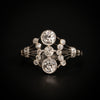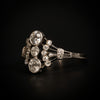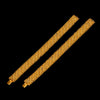This miniature carriage clock from our collection was made by Gustave Baugrand, made of gilt silver with enamelling by Antoine Tard, and is a rare highlight of French japonism from the 19th century.
In 1867, Japan had a pavilion at the Exposition Universelle in Paris. The country had reopened to the rest of the world not long before, so everything that came from there was in great demand. One of the techniques in which the Japanese excelled was cloisonné enamel: bright colors applied between wafer-thin threads of gold. This miniature carriage clock was made in the years after that world exhibition, with Japanese-style decorations in cloisonné enamel, a technique that is thousands of years old and experienced a revival in Europe in the 19th century. This carriage clock from Baugrand is an absolute highlight of French japonism and extremely rare.
Gustave Baugrand and Antoine Tard
Gustave Baugrand mainly made jewelry, including for Empress Eugénie, wife of Napoléon III. His jewels are rare today and still highly sought after. This carriage clock is an exception within Baugrand's total production. The enamelling is by Antoine Tard, who is best known for the Japanese-style enameled jewelry he made for Falize. The carriage clock is signed on the inside of the door on a royal blue enamel background with gold letters inspired by Japanese calligraphy.
Japonism in art
The Jan Taminiau gown that Queen Máxima wore on Budget Day in 2015 had floral motifs inspired by those in the Japanese Hall in Huis ten Bosch Palace. Great painters such as Vincent van Gogh, Monet, Manet and Klimt all created works in the Japanese style, and Puccini's Madame Butterfly is an example of Japonism in music.
Rare highlight of French japonism
03.04.2024













